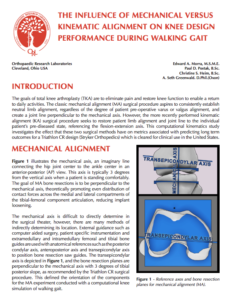 Relative motion at interacting implant surfaces generates wear debris over time leading to periprosthetic osteolysis and device failure. Factors related to implant design, patient habitus and surgical approach will impact the generation of wear debris and influence the clinical longevity of artificial spinal disc devices. Further, surgeons play an important role in selecting the appropriate implant size as well as its placement within the disc space to optimize soft tissue balance and alignment. Current wear testing standards for artificial discs do not account for the influence of anatomic structures or variations in disc placement. Dooris et al. suggested that anterior placement of the device led to increased facet joint loads in compression and extension. These findings suggest that if the implant is placed posteriorly within the disc, the spinal stiffness will be restored and facet loads will be maintained at pre-implantation levels. This handout describes the influence of neutral, anterior and posterior disc positioning on surface stresses and polymeric wear volumes using a finite element model and further seeks whether corroboration with clinical wear patterns exists.
Relative motion at interacting implant surfaces generates wear debris over time leading to periprosthetic osteolysis and device failure. Factors related to implant design, patient habitus and surgical approach will impact the generation of wear debris and influence the clinical longevity of artificial spinal disc devices. Further, surgeons play an important role in selecting the appropriate implant size as well as its placement within the disc space to optimize soft tissue balance and alignment. Current wear testing standards for artificial discs do not account for the influence of anatomic structures or variations in disc placement. Dooris et al. suggested that anterior placement of the device led to increased facet joint loads in compression and extension. These findings suggest that if the implant is placed posteriorly within the disc, the spinal stiffness will be restored and facet loads will be maintained at pre-implantation levels. This handout describes the influence of neutral, anterior and posterior disc positioning on surface stresses and polymeric wear volumes using a finite element model and further seeks whether corroboration with clinical wear patterns exists.
The Influence of Mechanical Versus Kinematic Alignment on Knee Design Performance During Walking Gait
Nov 8, 2017 | Knee

